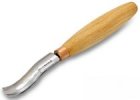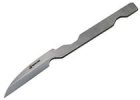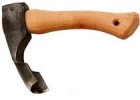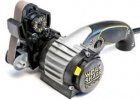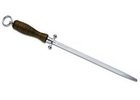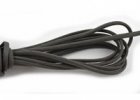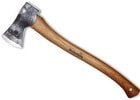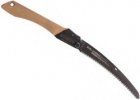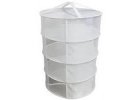
Steel is an alloy of iron with small amount of carbon to improve its strength and fracture resistance compared to iron. Many other alloying elements may be added to improve the steel quality and performance. Based on the knife steel composition we can talk about three main knife steel types.
1. Carbon steel 2. Tool steel 3. Stainless steel
Stainless steel
Stainless steel should contain at least 13% chromium, which ensures its corrosion resistance. The main advantage of stainless steel is corrosion resistance and only minimal care required.
154CM - stainless steel from the American manufacturer Crucible. 154CM steel was originally developed for the production of turbines for aircraft jet engines. Due to its versatility, it has also proved very useful in the production of knives. It is suitable for smaller folding knives as well as for large knives designed for heavier tasks. This steel offers a very well-balanced mix of important properties such as hardness, toughness and corrosion resistance.
Steel composition: 1,05% Carbon, 14% Chromium, 4% Molybdenum, 0,5% Manganese, 0,3% Silicon.
Knives with 154CM carbon steel here.
420 (AISI 420, 420J) – the lowest range among knife steels, used especially in low end knives. Blades made of this steel have good corrosion resistance. Edge holding ability is very low, meaning the knives need to be sharpened quite often. 420 stainless steel has low carbon content (<0.38%).
Steel composition: 0,15 - 0,38% Carbon, 13% Chromium, 1% Manganese, 1% Silicon, 0,6% Nickel, 0,09% Copper, 0,04% Phosphorus, 0,03% Sulfur
Knives with 420 stainless steel here.
420HC - this steel should not be mistaken for regular 420 steel. 420HC is stainless steel from American manufacturer Latrobe Specialty Steel. 420HC has higher carbon content than regular 420 stainless steel. The HC means high carbon - carbon content is 0,46%. 420HC steel can be brought to a higher hardness than regular 420. Steel 420HC is used for example by Buck Knives or Gerber Knives.
Steel composition: 0,46% Carbon, 13% Chromium, 0,4% Manganese, 0,4% Silicon, 0,3% Vanadium
440 (440A or 440B) - is higher quality steel compared to basic 420 steel. 440 stainless steel is also used especially for knives of lower price category. Slightly better edge holding ability and wear resistance than 420, as 440 series steels achieve higher hardness - usually from 55 to 59 HRC. Carbon content 0,65-0,95%. If the knife producers mentions 440 steel, it usually means 440A steel.
Steel composition (440A): 0,65 - 0,75% Carbon, 16 - 18% Chromium, 1% Manganese, 1% Silicon, 0,75% Molybdenum, 0,04% Phosphorus, 0,03% Sulfur
440C – the highest quality steel from the 4xx series, thanks to its high carbon content. Good quality stainless steel suitable for all common applications. It requires only minimal care and knives made of 440C are quite easy to sharpen. Steel 440C is highly corrosion resistant and also is capable to achieve a high hardness thanks to high carbon content. As you can see 440C is a really good all-round steel. Because of its quality and versatility 440C is one of the most common stainless alloys used for knife making. It is an especially good choice for an every day carry knife. The equivalent of 440C steel is Bohler's N695 steel.
Steel composition: 0,95 - 1,2% Carbon, 16 - 18% Chromium, 1% Manganese, 1% Silicon, 0,75% Molybdenum, 0,04% Phosphorus, 0,03% Sulfur
AR-RPM9 - steel AR-RPM9 is a stainless steel developed by the knife manufacturer Artisan Cutlery and CJRB. It is a stainless steel produced by the powder metallurgy method. The main advantages of this steel are good edge retention and wear resistance, easy sharpening and high corrosion resistance. Due to its properties, this steel is comparable to steels such as Sandvik 14C28N and D2.
Steel composition: 0.9% carbon, 18% chromium, 1% molybdenum, 0,45% manganese, 0,3% cobalt, 0,2 - 0,8% silicon, 0,1% vanadium, 0,4% nickel, 0,05% trace elements (sulfur, phosphorus)
Knives with AR-RPM9 steel here.
AUS-8 - stainless steel manufactured in Japan by Aichi Steel Corporation. It is comparable with 440B or 8Cr13MoV steels. It usually reaches a hardness of 57-59 HRC. AUS-8 steel can be sharpened quite easily to razor sharpness. It holds an edge only similar to 440B steel. Good quality steel from the middle range, with a good quality / price ratio.
Steel composition: 0,75% Carbon, 13 - 14,5% Chromium, 1% Silicon, 0,5% Manganese, 0,49% Nickel, 0,1 - 0,3% Molybdenum, 0,1 - 0,26% Vanadium, 0,04% Phosphorus, 0,03% Sulfur
CPM S30V - premium stainless steel produced by particle metallurgy method, from the American manufacturer Crucible Industries. S30V steel has been specially developed for the needs of the cutlery industry. It ihas a high content of carbon (1.4%), vanadium (4%) and molybdenum (2%). CPM S30V steel offers excellent edge retention and corrosion resistance. S30V is usually used for premium pocket knives or exclusive kitchen knives. For a long time, it has long been ranked among the top steels for knife production with an optimal balance of edge retention, hardness and toughness. S30V currently has a more popular brother S35VN, which is significantly similar, but thanks to niobium, this steel is easier for manufacturers to work with.
Steel composition: 1,45% carbon, 14% chromium, 4% vanadium, 2% molybdenum, 0,5% manganese, 0,5% silicon, 0,1 - 0,4% tungsten, 0,2% nickel, 0,04% phosphorus, 0,03% sulfur.
Knives with CPM S30V steel here.
CPM S35VN - premium stainless steel produced by particle metallurgy method, from the American manufacturer Crucible Industries. S35VN steel has high content of carbon (1,34%), vanadium (3%) and molybdenum (2%). The specialty of this steel (and at the same time an improvement over its predecessor S30V) is the addition of niobium (0.5%), which increases the toughness and ability to sharpen. One of the premium quality steels for the production of knives today. Excellent steel in all respects.
Steel composition: 1,34% carbon, 14% chromium, 3% vanadium, 2% molybdenum, 0,5% niobium, 0,5% manganese, 0,5% silicon, 0,4% tungsten, 0,1 - 0,4% nickel, 0,04% phosphorus, 0,03% sulfur.
Knives with CPM S35VN steel here.
CPM S90V - premium stainless steel produced by the particle metallurgy process, from the American manufacturer Crucible Industries. Steel is characterized by a very high carbon content (2,3%) and an extremely high vanadium content (9%). Thanks to these elements, S90V has excellent wear resistance and edge retention. The high proportion of chromium ensures very good corrosion resistance. It is one of the few highest quality steels for the production of knives today. Its only disadvantage is very difficult sharpening.
Steel composition: 2,3% carbon, 14% chromium, 9% vanadium, 1% molybdenum, 0,5% manganese, 0,5% silicon, 0,4% tungsten, 0,04% phosphorus, 0,03% sulfur.
Knives with CPM S90V steel here.
CTS XHP - powder metallurgy, air hardenable stainless steel from the US manufacturer Carpenter. CTS XHP steel was patented in 1994 and was designed as a steel that combines the best properties of 440C and D2 steels. The 440C has good corrosion resistance, but its maximum hardness is a bit low. D2 has excellent hardness, but 12% chromium in D2 does not guarantee the corrosion resistance of stainless steel. CTS XHP steel combines high hardness (up to 64 HRC), high wear resistance and high corrosion resistance. Sharpening the CTS XHP steel knife is relatively easy despite its high hardness. It is much easier than sharpening of stainless steels with a high vanadium content (eg M390, S90V, etc.).
Steel composition: 1,60% carbon, 16% chromium, 0,80% molybdenum, 0,50% manganese, 0,45% vanadium, 0,4% silicon, 0,35% nickel.
Knives with CTS XHP steel here.
N690 - stainless steel enriched with cobalt from the Austrian manufacturer Bohler-Uddeholm. The N690 steel is similar in its parameters to the 154CM steel or the Japanese VG-10 steel. N690 is a high-quality stainless steel with a hardness of 58 - 61 HRC and very good edge retention. It is not as hard as premium super steels, but its hardness is above average and absolutely sufficient for ordinary users. The big advantage of N690 steel is the easy sharpening and toughness (edge is not brittle). Excellent steel for outdoor knives, hunting knives and for EDC folding knives.
Steel composition: 1.08% carbon, 17.3% chromium, 1.5% cobalt, 1.1% molybdenum, 0.4% silicon, 0.4% manganese, 0.1% vanadium.
N695 - equivalent of 440C steel, made by Austrian manufacturer Böhler-Uddeholm. Unlike N690, it does not contain cobalt, and has a lower molybdenum content. It is a good quality steel for knives with a hardness of 57 - 60 HRC. N695 is hard chrome-alloyed stainless steel, with high resistance to wear and corrosion.
Steel composition: 1.05% carbon, 16.7% chromium, 0.5% molybdenum, 0.4% silicon, 0.4% manganese.
Sandvik 12C27 – swedish stainless steel from Sandvik Materials Technology. It is widely used in knife industry for example by Morakniv or Opinel knives. Excellent steel for regular use - it is easy to sharpen and holds the edge quite well. This steel can reach a hardness of 57 - 59 HRC. Excellent price/quality ratio.
Steel composition: 0,6% carbon, 13,5% chromium, 0,4% manganese, 0,4% silicon, 0,03% phosphorus, 0,01% sulfur.
Sandvik 14C28N – swedish stainless steel from Sandvik Materials Technology. Very high quality steel with a hardness of 58 - 62 HRC. The optimized composition of elements creates a combination of desired properties such as excellent edge retention, high hardness and good corrosion resistance. To increase corrosion resistance, nitrogen (0.11%) is added to this steel. The 14C28N steel can be sharpened razor sharp and has very good edge retention. The stability of the edge in terms of micro breaking, bending or rolling of the edge is very good.
With a recommended hardness of up to 62 HRC, the 14C28N steel is ideal choice for knives with high demand on sharpness, edge resistance and corrosion resistance, such as outdoor and bushcraft knives, pocket knives, hunting and fishing knives, but also kitchen knives.
Steel composition: 0,62% carbon, 14% chromium, 0,6% manganese, 0,2% silicon, 0,11% nitrogen, 0,025% phosphorus, 0,01% sulfur.
Knives with 14C28N steel here.
RWL-34 – stainless steel made by powder metallurgy technology. The manufacturer is the Swedish company Damasteel AB. RWL-34 is one of the top knife steels, it can reach a hardness of 59-64 HRC, it has very good resistance to corrosion and very good edge retention.
Steel composition: 1,05% carbon, 14% chromium, 4% molybdenum, 0,50% manganese, 0,5% silicon, 0,2% vanadium.
Knives with RWL-34 steel here.
VG-10 – very popular stainless steel from the Japanese manufacturer Takefu. VG10 has very fine carbide structure and due to its properties it is often used on high quality Asian kitchen knives and folding knives. VG 10 steel is stainless steel with a high carbon content. Thanks to this, it is resistant to corrosion, achieves a very high sharpness and is relatively easy to sharpen. It typically reaches a hardness of 60-61 HRC. It is slightly prone to pitting, so we recommend keeping VG-10 knives dry and clean. It is important not to wash in the dishwasher or leave in the sink. If spot corrosion appears, it must be sanded or polished so that it does not spread further.
VG-10 steel kitchen knives are usually made of laminated steel. VG-10 steel forms a hard core that is sandwiched between two sheets of soft stainless steel. This process produces three-layer steel. A combination of VG-10 steel core and Damascus steel side plates is also often used. This is how, for example, the popular 67-layer Damascus knives are created - a combination of two sheets of 33-layer Damascus and a VG-10 core.
Steel composition: 1% carbon, 14,5 - 15,5% chromium, 1,2% molybdenum, 1,5% cobalt, 0,5% manganese, 0,3% vanadium, 0,03% phosphorus
Kitchen knives with VG-10 steel here.
X50CrMoV15 (1.4116) – high-alloy German steel with very high corrosion resistance. Thanks to this, it is used primarily on kitchen or hunting knives. It is not high carbon steel, despite some marketing claims. However, steel X50CrMoV15 is tough enough and resists corrosion well. If you don't want to bother with knife maintenance, knife made of X50CrMoV15 (1.4116) steel is a good choice. This steel is used by world-famous manufacturers such as Böker, F. Dick, Opinel, Wusthof, Victorinox, Zwilling and others.
Steel composition: 0,5% carbon, 14-15% chromium, 1% manganese, 0,5 - 1,0% silicon, 0,5-0,8% molybdenum, 0,1-0,2% vanadium.
Knives with X50CrMoV15 (1.4116) steel here
Kitchen knives with X50CrMoV15 (1.4116) steel here.
Tool steel
Tool steel carbon content is usually in range of 0,5 - 1,5% (sometimes even more) and is characterized by high content of alloying elements such as chromium, molybdenum, vanadium, tungsten and others. Knife tool steel combine the advantages of stainless and carbon steel.
The main advantages of tool steels are high hardness, toughness and very high wear resistance. Thanks to these properties, tool steel is the perfect choice for outdoor and bushcraft knives.
Tool steels are significantly more expensive than conventional stainless or carbon steels. Their high price is caused mainly by the very high content of alloying elements, but also by the complex metallurgical production process.
CPM 4V - powder metalurgy tool steel made by Crucible Industries. CPM-4V steel combines high impact toughness and wear resistance with high hardness. Thanks to high wear resistance, knives made from CPM-4V steel do not require frequent sharpening. CPM 4V is an excellent knife steel, suitable especially for outdoor and bushcraft knives.
Steel composition: 1,35% Carbon, 5% Chromium, 3,85% Vanadium, 2,95% Molybdenum, 0,8% Silicon, 0,4% Manganese.
Knives with CPM 4V steel here.
D2 – is semi-stainless tool steel, thanks to the 12% chromium content (steels with 13% and more are classified as stainless). D2 is one of the most popular knife steels, because of it great price / quality ratio. D2 steel is produced by various manufacturers worldwide. The high carbon content (1,5%) ensures excellent edge retention. D2 is high end steel with usual hardness of 60 - 62 HRC. The combination of excellent resistance to wear, high hardness and ouite good corrosion resistance (almost stainless steel) make D2 steel an excellent choice, especially for bushcraft knives, survival knives or combat knives.
Equivalent of D2 steel is Böhler-Uddeholm made K110 steel.
Niolox (SB1, 1.4153.03) - semi-stainless tool steel from the German manufacturer Lohmann. It combines high corrosion resistance and very good edge retention. Thanks to the niobium content, Niolox steel is very fine-grained, which helps the edge stability. The hardness of the steel varies between 58 - 63 HRC. Niolox is comparable to D2 steel, but has even better edge retention and toughness.
Steel composition: 0,8% Carbon, 12,7% Chromium, 1,1% Molybdenum, 0,9% Vanadium and 0,7% Niobium.
Knives with Niolox steel here.
PGK - tool steel produced by the German manufacturer Lohmann, or US Latrobe. It combines excellent edge retention, high wear resistance, high toughness and is highly resistant to chipping. It is not stainless steel, but its corrosion resistance is higher than that of classic carbon steels. The optimal hardness of PGK steel is 62 - 63 HRC. Thanks to these properties, it is very suitable for larger knives used for hard work, such as chopping, batoning etc.
The properties and composition of PGK steel are very similar to CPM Cru-wear, Vascowear and SB Wear steels.
Steel composition: 1,15% Carbon, 8,2% Chromium, 2% Vanadium, 1,5% Molybdenum, 1,5% Tungsten, 1% Silicon, 0,4% Manganese
Sleipner - tool steel from Bohler-Uddeholm. Sleipner is a modification of D2 steel. Sleipner steel has good wear resistance and edge retention comparable to D2 steel. At the same time, however, it is more resistant to chipping and has higher toughness (compared to D2). It can reach a hardness of 60-64 HRC. Sleipner is not stainless steel, but its corrosion resistance is higher than that of classic carbon steels.
Steel composition: 0,9% carbon, 7,8% chromium, 2,5% molybdenum, 0,9% silicon, 0,5% vanadium, 0,5% manganese.
Knives with Sleipner steel here.
Carbon steel
Carbon steel is a basic type of steel containing iron and carbon. Some types of carbon steel may contain small amout of alloying elements, such as manganese, nickel or other elements. The carbon content is usually in the range of 0.3% - 1.25%, but there may be exceptions. The higher the carbon content of the steel, the higher its hardness and the lower the toughness.
The main advantages of carbon steel are toughness, good blade grip and very easy grinding. For this reason, carbon steel is very popular for nature knives, bushcraft and survival knives. Carbon steels with a lower carbon content (usually around 0.4% - 0.7%) are characterized by very high toughness and are therefore used primarily for the production of kittens or axes.
The disadvantage of carbon steel is its low corrosion resistance. Manufacturers often use blade coating to increase corrosion resistance. Carbon steel knives require regular care. After every use, rinse the blade, wipe it clean, and oil it to prevent rust.
1066 (65G, 66Mn4, 65Mn) – carbon steel commonly used in the production of knives, chopping tools, and wood carving tools. 65G is a carbon spring steel that is easy to sharpen and you can achieve high sharpness of edge. One of the biggest advantages of this steel is high yield strength´, elasticity and durability - spring steel can withstand intense twisting and bending without being deformed. At the same time, however, knives and tools made of this steel needs proper care and maintenance, as it corrodes relatively easily.
Steel composition: 0,60 - 0,71% carbon, 0,8 - 1,1% manganese, 0,17 - 0,37% silicon, 0 - 0,25% chromium, trace amounts of phosphorus and sulfur
Knives with 1066 (65G, 66Mn4, 65Mn) carbon steel here
1075 – carbon steel most commonly used in construction of knives, cutting tools, but also springs. It contains 0,7 - 0,8% carbon, 0,4 - 0,7% manganese and trace amounts of phosphorus and sulfur. It is really easy to sharpen and you can easily achieve very high sharpness of the edge. 1075 is very tough steel with great resistance to chipping. On the other hand, 1075 steel has a very low corrosion resistance. It rusts very easily, therefore it is necessary to pay attention to proper care and maintenance. After every use, rinse the blade, wipe it clean, and oil it to prevent rust. Compared to 1095 steel, it has lower hardness and higher toughness, which makes it great choice for large knives or machetes designed for chopping and rough work.
Steel composition: 0,7 - 0,8% Carbon, 0,4 - 0,7% Manganese, traces of Phosphorus and Sulfur
Knives with 1075 carbon steel here
1086 (XC90) – high carbon steel used for example on Opinel knives. Carbon steel 1086 is easy to sharpen and you can easily achieve very high sharpness of the edge. 1086 steel has a very low corrosion resistance. It rusts very easily, therefore it is necessary to pay attention to proper care and maintenance.
Steel composition: 0,8 - 0,93% Carbon, 0,3 - 0,65% Manganese, traces of Phosphorus and Sulfur
Knives with 1086 (XC90) carbon steel here
1095 knife steel
1095 - high carbon steel most commonly used in knife and sword making. It is very easy to sharpen and you can easily achieve very high sharpness of the edge. 1095 is very hard steel with great edge retention and good wear resistance. On the other hand, 1095 steel has a very low corrosion resistance. It rusts very easily, and needs proper care and maintenance. After every use, rinse the blade, wipe it clean, and oil it to prevent rust.
1095 steel is used by many knife makers, for example, by Condor, ESEE or Ontario. Compared to other steels in the 10xx series (1060, 1075, 1084, etc.), it has the highest carbon content, so it has the best edge retention and lower toughness.
Steel composition: 0,95% Carbon, 0,3 - 0,5% Manganese, traces of Phosphorus and Sulfur
Knives with 1095 carbon steel here
Equivalents of 1095 steel:
C100 – equivalent of 1095 steel. It is almost identical to steel 1095 (1% carbon, 0.5% manganese). It normally reaches a hardness of 58-60 HRC. Very hard steel with great edge retention and good wear resistance. On the other hand, C100 steel has a very low corrosion resistance. It rusts very easily, and needs proper care and maintenance. After every use, rinse the blade, wipe it clean, and oil it to prevent rust.
UHB20C – equivalent of 1095 steel, made by Böhler-Uddeholm. UHB20C is almost identical to steel 1095 but cleaner alloy (contains less sulphur and phosphorus). It normally reaches a hardness of 58-60 HRC. Very hard steel with great edge retention and good wear resistance. On the other hand, UHB20C steel has a very low corrosion resistance.
80CrV2 (L2, 1.2235) – tough high carbon spring steel, very often used on scandinavian knives. 80CrV2 steel is known for its extreme toughness and quite good hardness at the same time. On top of that, this steel is easy to sharpen. Due to its high toughness, it is also used for large nordic knives designed for chopping - leuku. 80CrV2 is a great choice also for survival and outdoor knives. It rusts quite easily, and needs proper care and maintenance. After every use, rinse the blade, wipe it clean, and oil it to prevent rust. This steel is sometimes referred to as L2 or 1.2235.
Steel composition: 0,85% Carbon, 0,6% Chromium, 0,3 - 0,5% Manganese, 0,4 % Nickel, 0,15 - 0,25% Vanadium, 0,3% Silicon, 0,1% Molybdenum, traces of Phosphorus and Sulfur
Knives with 80CrV2 carbon steel here
.png)









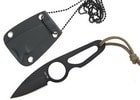





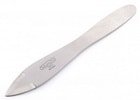










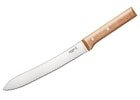
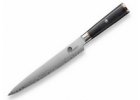

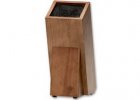



-min.jpg)









